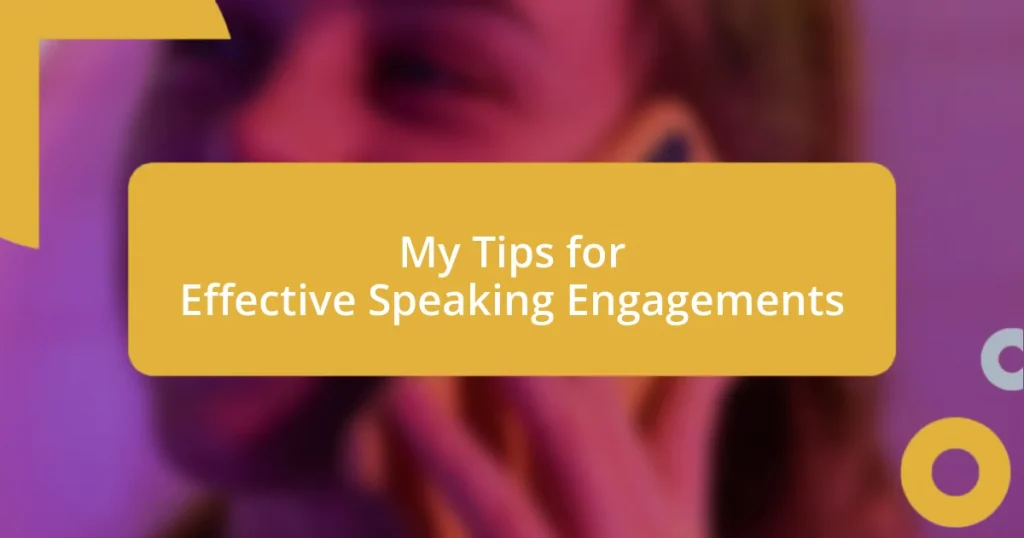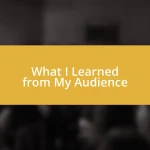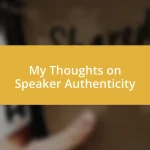Key takeaways:
- Understanding your audience’s emotions and motivations enhances engagement; tailoring content and encouraging dialogue fosters deeper connections.
- Crafting your key message requires clarity, simplicity, and emotional relevance, making it easier for the audience to grasp and retain information.
- Incorporating interactive elements and effective body language during presentations creates a more engaging and dynamic experience, fostering participation and connection.

Understanding Your Audience
Understanding your audience is crucial for any speaking engagement. I remember a time when I spoke to a group of college students about career readiness. Initially, I tailored my content for professionals. However, I quickly realized that the students were more interested in practical, actionable advice rather than abstract concepts. This shift in perspective made a huge difference in my delivery and their engagement.
Have you ever noticed how different audiences respond to various topics? When addressing a mixed group, I often engage in a bit of informal dialogue to gauge their interests. I’ve found that asking questions like, “What challenges do you face in your daily lives?” invites them into the conversation. This not only creates a connection but also helps me adjust my material on the fly to ensure it resonates with everyone in the room.
Knowing your audience goes beyond demographics; it’s about understanding their emotions and motivations. I once spoke at a community event that targeted individuals in a transitional phase of their lives. Knowing this, I infused personal stories of struggle and triumph into my presentation. This emotional resonance turned a simple talk into a meaningful dialogue, helping me connect deeply with the audience and leaving them inspired. Can you recall a moment when you felt truly understood during a presentation? That’s the kind of connection we should strive for.
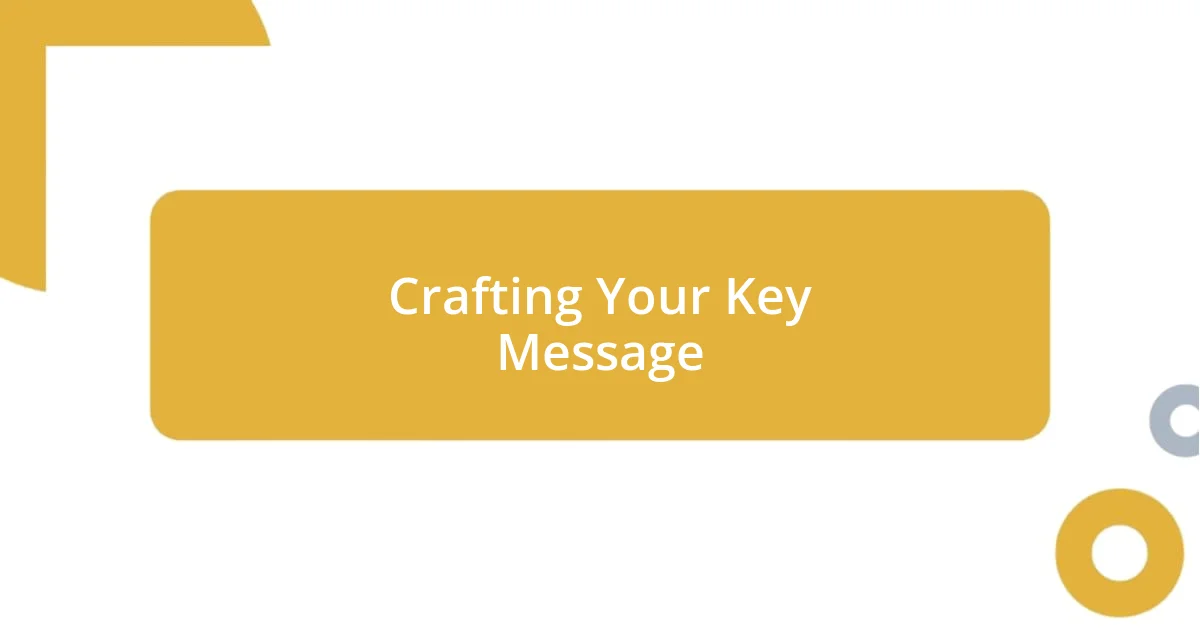
Crafting Your Key Message
Crafting your key message is like shaping clay; it requires focus and intention. I remember one time when I had to prepare for a workshop on effective communication. Initially, I tried to cover every aspect of the topic, but I soon realized that narrowing my focus made a significant impact. By distilling my message down to three core points, I not only kept myself on track but also made it easier for my audience to grasp and retain the information.
To effectively craft your key message, consider these elements:
- Clarity: Be straightforward. Avoid jargon. Think about the essence of what you want to convey.
- Simplicity: Strip away the unnecessary details. Focus on one main idea.
- Emotion: Connect with your audience on an emotional level. Use relatable stories that evoke feelings or memories.
- Relevance: Make your message pertinent to the audience’s experiences. Tie it back to their needs and interests.
- Call to Action: Encourage your audience to take the next step. What should they do with the information you’ve shared?
By investing time in refining your message, you’re setting a solid foundation for an engaging and impactful speaking engagement.

Organizing Your Presentation Effectively
Organizing your presentation effectively is essential for both clarity and engagement. I once found myself overwhelmed during a speaking engagement because my thoughts were scattered. I learned the hard way that having a clear outline can make all the difference. By structuring my presentation with a beginning, middle, and end, each segment naturally led into the next, allowing my audience to follow along without losing track.
Moreover, using visual aids can enhance the organization of your presentation. A well-designed slide deck helped me convey complex information simply. For instance, during a tech conference, I used infographics to summarize data, which not only captured attention but also provided a clear roadmap for my audience. This approach ensured they could easily grasp the concepts I was sharing, making the entire experience more fulfilling for everyone involved.
One technique I find particularly helpful is to use stories as a framework for my key points. When I spoke at a recent community meetup, I shared a personal experience that directly related to the topic I was discussing. This method organized my thoughts around that central story, allowing me to guide the audience through my message while keeping them emotionally invested. Have you ever noticed how a story can keep you engaged? It’s remarkable how the human brain is wired to connect with narratives, making it a powerful tool for effective organizing.
| Technique | Description |
|---|---|
| Clear Outline | Divide your presentation into a structured beginning, middle, and end. |
| Visual Aids | Use infographics or slides to simplify complex data and enhance understanding. |
| Storytelling | Incorporate personal stories to guide your audience and make your message relatable. |
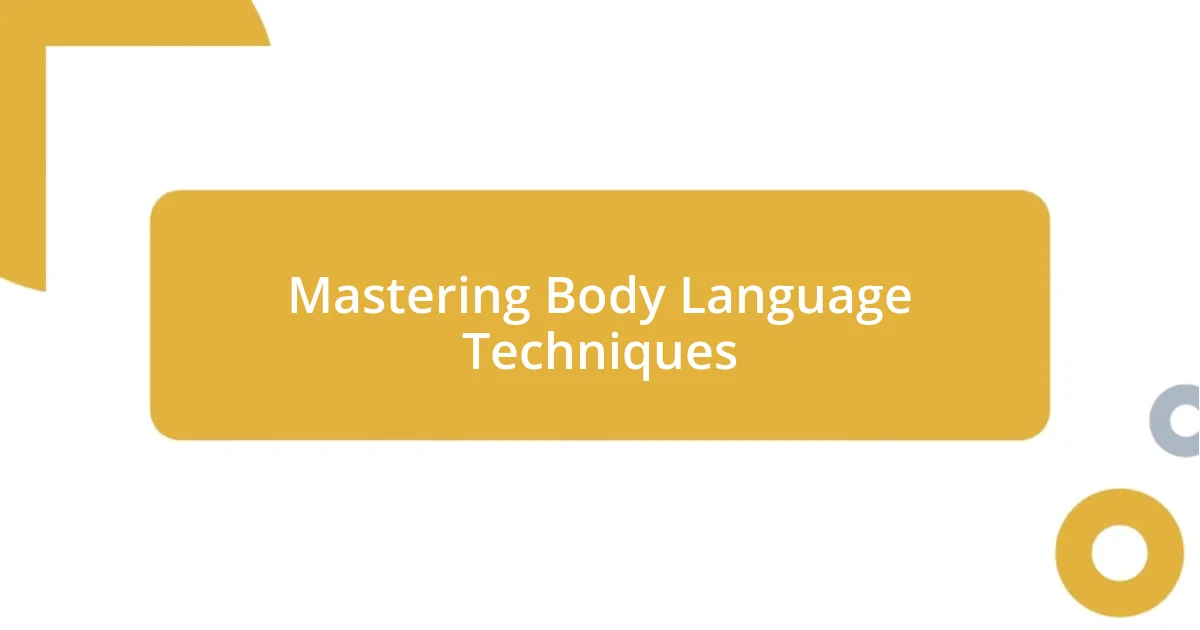
Mastering Body Language Techniques
When it comes to body language, I’ve learned that nonverbal cues often speak louder than words. For instance, during one of my first speaking engagements, I noticed the audience’s reactions to my posture. Standing upright and open made me feel more confident, and it visibly encouraged the audience to lean in and engage. This connection showcased the importance of inviting presence; it’s amazing what a small shift can accomplish.
Have you ever felt the weight of someone staring right at you while they spoke? It’s both intimidating and captivating. I remember when I intentionally practiced eye contact during a presentation, and I could feel the room transform with that simple technique. When I locked eyes with my audience, not only did they seem more connected, but my nervousness melted away. It’s a powerful reminder that effective body language can enhance your message.
Using gestures is another tool I’ve found invaluable in my speaking toolbox. A few years ago, I experimented with hand movements to illustrate my points. This technique helped clarify complex ideas and made my presentation more dynamic. For example, when discussing growth strategies, I used upward hand movements to symbolize progress, making my message resonate clearly with the audience. How often do you think about the impact of your gestures? I’ve come to realize that incorporating them meaningfully adds an extra layer to what you’re saying, enhancing understanding and retention.

Practicing for Confidence and Clarity
Practicing for a speaking engagement is like rehearsing for a big performance. I vividly remember my own efforts leading up to a workshop where I was so nervous that I could barely keep my hands still. As I practiced in front of a mirror, I noticed how my clarity improved with each run-through. I could see myself and tweak my pacing and tone. It’s incredible how much repetition can enhance confidence!
One approach I swear by is recording my practice sessions. I did this for a recent keynote speech and was shocked by how many filler words like “um” and “uh” I was using. By listening to the playback, I could identify the patterns in my speech and adjust accordingly. Isn’t it strange how we often don’t realize these habits until we see or hear ourselves? You might find this technique helpful—it not only bolstered my clarity but significantly boosted my confidence, knowing I was eliminating distractions.
Lastly, I’ve discovered that practicing with a partner can elevate the experience. I once co-practiced with a friend before a community event, and the feedback was invaluable. They pointed out areas where I could elaborate more or adjust my tone for emphasis. Engaging with someone else added a layer of accountability and made my practice feel more dynamic and less isolating. Have you ever practiced with a friend? It turns out that a second pair of eyes—and ears—can provide insights you never considered on your own!
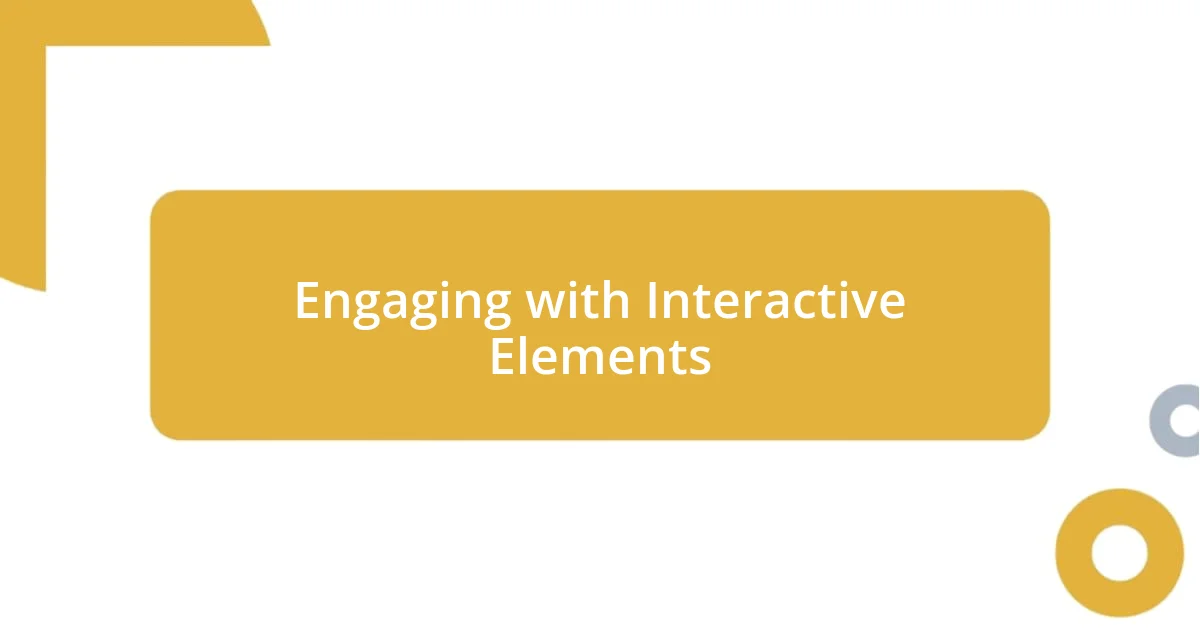
Engaging with Interactive Elements
Incorporating interactive elements can transform a presentation from a monologue into a conversation. I remember once using live polls during a workshop, and the energy in the room shifted dramatically. When the audience’s opinions came up on the screen, I could see their engagement spark—suddenly, they were not just listening; they were part of a lively discussion. Have you ever seen people light up when their voices are heard? It’s a pretty magical moment.
Including Q&A sessions is another effective strategy I’ve found. At one event, I opened the floor to questions after my talk, and it created an immediate connection with the audience. It was enlightening to hear their thoughts and foster a back-and-forth dialogue. There’s something incredibly validating about addressing their curiosities. What have you experienced when you invite questions? For me, it takes the pressure off and establishes a more personal rapport.
Finally, I’ve explored hands-on activities as part of my engagement toolkit. During a recent seminar, I had attendees break into small groups to brainstorm solutions to a common challenge. The room buzzed with collaboration, and it was inspiring to witness diverse insights. Those shared experiences not only deepened their understanding but also built a sense of community among participants. Have you ever engaged in a group activity and felt that surge of camaraderie? It’s a fantastic way to leave everyone feeling energized and connected.

Handling Q&A Sessions Seamlessly
When it comes to Q&A sessions, I’ve found that creating an inviting atmosphere is key. During one memorable experience, I noticed how relaxed everyone felt when I encouraged questions with a simple smile. I made sure to express appreciation for every inquiry, even those that challenged my points. Have you ever felt validation after asking a question? That’s what I strive to evoke in my audience—making them feel valued and important in the conversation.
One technique that has really helped me is to paraphrase the question before answering. For instance, during a recent talk on leadership, someone asked about managing conflict. I first rephrased their question, saying, “So, you’re curious about effective conflict resolution techniques?” This not only ensured I understood their concern but also engaged the entire audience. I find it interesting how this practice can underscore that every voice matters; it transforms a simple Q&A into a collaborative exchange of ideas.
I also recommend being mindful of your body language during Q&A sessions. I recall a time when I sat down on the edge of the stage instead of standing behind the podium. It immediately changed the dynamics—people approached with greater ease. Have you noticed how spatial dynamics can influence interaction? By shifting my posture and creating an open stance, I felt that folks were more willing to share their thoughts, leading to a more enriching dialogue for everyone involved.










